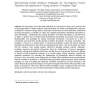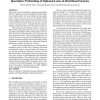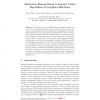467 search results - page 71 / 94 » Using the DEVS Paradigm to Implement a Simulated Processor |
SAC
2006
ACM
14 years 1 months ago
2006
ACM
: In chip design, one of the main objectives is to decrease its clock cycle; however, the existing approaches to timing analysis under uncertainty are based on fundamentally restri...
PDCN
2004
13 years 9 months ago
2004
We present a family of methods for speeding up distributed locks by exploiting the uneven distribution of both temporal and spatial locality of access behaviour of many applicatio...
COMPUTER
2002
13 years 7 months ago
2002
tail defines the level of abstraction used to implement the model's components. A highly detailed model will faithfully simulate all aspects of machine operation, whether or n...
ICIAP
2005
ACM
14 years 1 months ago
2005
ACM
This paper shows how Markovian segmentation algorithms used to solve well known computer vision problems such as motion estimation, motion detection and stereovision can be signiÔ¨...
ISCA
2007
IEEE
14 years 1 months ago
2007
IEEE
The negative performance impact of branch mis-predictions can be reduced by exploiting control independence (CI). When a branch mis-predicts, the wrong-path instructions up to the...



